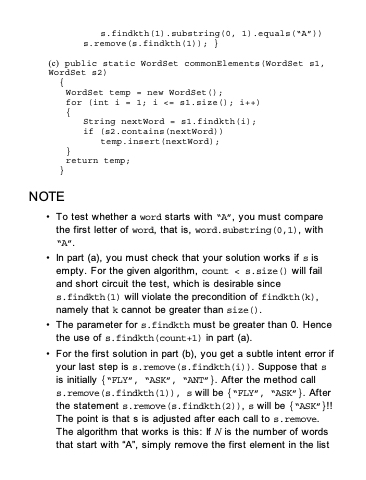Page 1275 - AP Computer Science A, 7th edition
P. 1275
s.findkth(1).substring(0, 1).equals(“A”)) s.remove(s.findkth(1)); }
(c) public static WordSet commonElements(WordSet s1, WordSet s2)
{
WordSet temp = new WordSet();
for (int i = 1; i <= s1.size(); i++) {
String nextWord = s1.findkth(i); if (s2.contains(nextWord))
temp.insert(nextWord);
}
return temp; }
NOTE
• To test whether a word starts with “A”, you must compare the first letter of word, that is, word.substring(0,1), with “A”.
• In part (a), you must check that your solution works if s is empty. For the given algorithm, count < s.size() will fail and short circuit the test, which is desirable since s.findkth(1) will violate the precondition of findkth(k), namely that k cannot be greater than size().
• The parameter for s.findkth must be greater than 0. Hence the use of s.findkth(count+1) in part (a).
• For the first solution in part (b), you get a subtle intent error if your last step is s.remove(s.findkth(i)). Suppose that s is initially {“FLY”, “ASK”, “ANT”}. After the method call s.remove(s.findkth(1)), s will be {“FLY”, “ASK”}. After the statement s.remove(s.findkth(2)), s will be {“ASK”}!! The point is that s is adjusted after each call to s.remove. The algorithm that works is this: If N is the number of words that start with “A”, simply remove the first element in the list


